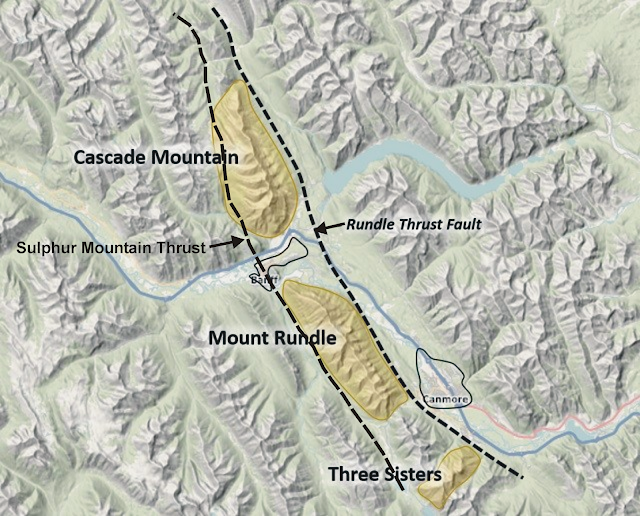Here is a close up of the image on the front of the bottle. The mountain is extremely easy to see from the town of Banff, as shown in the picture below. The mountain itself is not glacial in origin, however I have included it in my Drunk on Glaciology portion because of the heavy impact glaciers had on the mountain landscape itself as well as the surrounding region such as the glacially formed U-shaped valleys carved out of the thrust fault valleys described below.
 |
| Location of Mount Rundle and Cascade Mountain in relation to the neighboring thrust faults and the town of Banff. Image modified from Travel Tales of Life. |
 |
| Diagram of the formation of Mount Rundle along the thrust fault. Image is shown flipped where the fault should be dipping towards the west (left). Image courtesy of Travel Tales of Life. |
 |
| Geology of Mount Rundle highlighted. Image courtesy of the Geological Survey of Canada. Mr - Mississippian Rundle Limestone; Mb = Mississippi Banff shales; Dp = Devonian Palliser limestone cliffs |
Mount Rundle is primarily made up of three geological formations. The Palliser limestone (aka Palliser Formation) is a Late Devonian (~360 million years old) that was deposited along a warm, coastal shelf environment, very similar to the Bahama Banks today. Then above that along the more eroded slopes is the Banff Shale. The Banff Shale (aka Banff Formation) is also a Late Devonian age deposit that was deposited in a sediment rich marine environment. And the top of the mountain is capped with the resistant Rundle limestone. The Rundle Limestone (aka the Rundle Group) is a Mississippian age (~340 million year old) limestone deposited in a marine environment.
"From 100% locally-farmed Alberta grain. Double distilled in our hand-built Kothe copper column still. Steeped with organic espresso beans from the Banff Roasting Company. Just like a rich cup of coffee brewed over an early morning campfire. But with vodka. So even better.
Vista - Mount Rundle"






No comments:
Post a Comment
Due to spam, comments are turned off. Please contact me on Twitter @Jazinator for any comments.
Note: Only a member of this blog may post a comment.